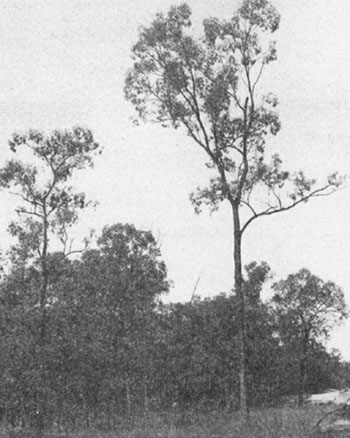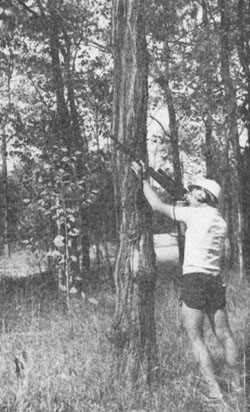by
D.J. Boland
Division of Forest Research, CSIRO
P.O. Box 4008, Queen Victoria Terrace
Canberra, A.C.T. 2600 Australia
INTRODUCTION
Eucalyptus species of the Ironbark group 1 are very conspicuous in the Australian landscape because of their rugged, hard, furrowed, dark-coloured bark. They are highly prized for use wherever great strength and long durability of the wood is required, and are used commonly for railway sleepers, bridges, telephone and electrical poles and for farm fences. They are sometimes called “Kings of the Hardwoods” in Australia.
To date, most of Australia's needs for wood from this group have been met from existing extensive natural stands. However, there have recently been some indications that supplies from these stands are dwindling.
In the past, only modest attempts have been made to establish Ironwood plantations. These now total approximately 600–800 ha in Australia, and are found mainly in the states of Queensland, New South Wales, Victoria and South Australia.
Ironbarks have proved moderately successful overseas. According to Pryor (1976) the main species planted have been E. sideroxylon, E. paniculata, and E. melanophloia. About 5,000 ha of E. sideroxylon have been established in Morocco, North Africa (Turnbull and Pryor 1978). Other countries from which ironbark plantations have been reported are South Africa, India, Pakistan, China and Brazil.
Climatically, Ironbarks grow under a wide range of conditions from Mediterraneantype sites in the State of Victoria to monsoonal areas in northern Australia; however, they are most plentiful in the subtropical regions. They often form good-sized trees on very poor quality and shallow soils.
About 14 of the approximately 20 species occur in Queensland, where they probably represent the most common group of trees in terms of numbers of individual trees.
In spite of their potential for world forestry, eucalypts in the Ironbark group have, in the past, been inadequately sampled and tested. Their uncertain taxonomy has also obstructed earlier attempts to promote their use in plantation forestry.
BACKGROUND AND OBJECTIVES OF THE 1982 COLLECTIONS
In May and June 1982, Ironbark seed was collected from 19 sites in Queensland, Australia representing seven named and three un-named species of eucalypts.
The collections ranged over eight degrees of latitude, mostly subtropical; collection sites covered a wide range of environmental conditions from wet coastal areas fringing rainforests to inland areas having a pronounced dry season.
The trip, funded by the Department of Forestry, Queensland through the Australian Development Assistance Bureau, represents the first major attempt to systematically sample ironbark species and provenances in Australia.
The collection team involved two officers from the Division of Forest Research, CSIRO, and two officers from the Department of Forestry, Queensland; it lasted approximately three weeks.
METHODOLOGY AND RESULTS
During the trip, seed of 10 species was collected from a total of 19 sites. Generally, collections were made from 5–10 mother trees per site; a.308 calibre rifle was used to sever seed-bearing limbs for the collection (see Figures 1 and 2, page 26).
The seven named species collected were the following:
E. crebra (5 provenances; 2907 g); E. decorticans (1 provenance; 121 g), E. drepanophylla (4 provenances; 1391 g); E. fibrosa subsp. nubila (1 provenance; 110 g); E. melanoleuca (1 provenance; 153.5 g); E. melanophloia (1 provenance; 474 g), and E. whitei (1 provenance; 297 g).
In addition, seed was collected from three undescribed species, viz: E.“blackdownii” (600 g), E. aff. cullenii (1290 g), and E. aff. crebra (1000 g).
SEED AVAILABILITY
Some seed of E. drepanophylla will be used by the Department of Forestry, Queensland to establish species/provenance trials of eucalypts in China under an Australian bilateral assistance programme. Research quantities of the remaining seed will be made available to interested countries upon request; the requests should be addressed to:
Seed Centre
CSIRO Division of Forest Research
(Attention Mr. J.C. Doran)
P.O. Box 4008
Canberra, A.C.T. 2600
Australia.
REFERENCES
Pryor, L.D. 1976 The Biology of Eucalypts. Edward Arnold, London.
Turnbull, J.W. and Pryor, L.D. 1978 Choice of species and seed sources. In: Eucalypts for Wood Production (Chapter 2) (Eds. W.E. Hillis and A.G. Brown). Griffin Press, Adelaide.
 Figure 2. Collection of seed by using a .308 calibre rifle (Clermont area, Queensland, Australia). | Figure 1. Eucalyptus crebra, Drummond Range, Queensland (Australia). ←  |
| → |
Article received July 1982.